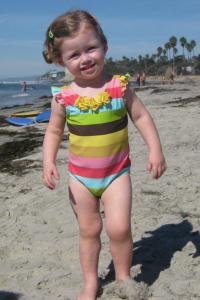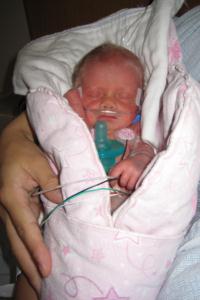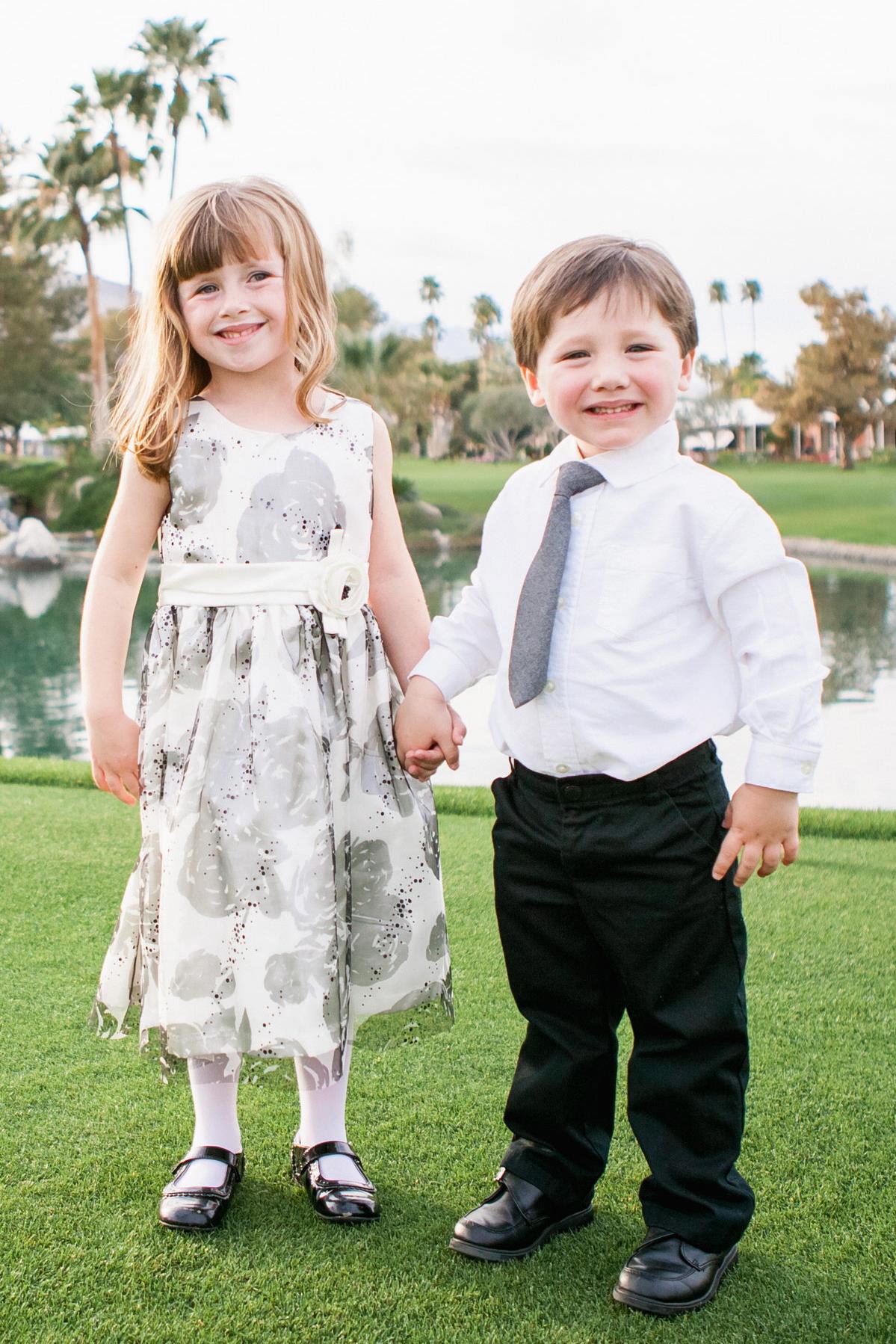

Lola
Mosaic Trisomy 16
Everything about my pregnancy was very normal until my first trimester screening.
On the ultrasound, the nuchal fold measured
2 mm which is on the higher end of normal
(we were told the normal range is 1.5 – 2.3). Just days before Christmas we got the results of the blood test showing that our baby had
a 1 in 27 risk for Down Syndrome (normal
for my age was 1 in 800). We were in complete shock. I was only 27 and neither
of our families had any history of genetic disorders.
At my 18 week ultrasound, there were three “markers” for Downs – slightly shorter femur bones, a collection of fluid around the baby’s scalp and a small VSD (a hole in the wall between the two ventricles in the heart). The perinatologist explained the results and recommended an amnio, but we declined and made an appointment for another ultrasound 3 weeks later. At 21 weeks, the VSD was confirmed and we were referred to a pediatric cardiologist for a detailed fetal echo. At this point we decided that it would be best to know if there were any other complications and scheduled the amnio for three days later.
The amnio went smoothly and while we waited for the results, we saw the pediatric cardiologist. We were shocked and elated to hear that he saw no evidence of a VSD on the echo. Unfortunately our joy was short-lived because the next day we received the results of the amnio. We were told that our baby had a “very severe condition” called Mosaic Trisomy 16 and that they knew very little about the potential outcome. A phone consultation with a clinical geneticist was set up for the following week but this left us with four grueling days until we could find out what the diagnosis actually meant for our baby. Almost everything we could find online suggested severe consequences and little reason to believe our baby would have any chance at normal life. Fortunately we found the DOC16 site and connected with Rosalyn and other parents who gave us some hope for a positive outcome.
The geneticist was also very helpful and explained as much as she could about MT16 and the possible effects on our baby. After talking with her we decided that going forward we would just try to stay positive and focus on the joy of being pregnant. We started seeing the perinatologist once a month and also having monthly ultrasounds to monitor growth and development. After a month we started seeing a slight decline in the baby’s growth and started having ultrasounds every three weeks and OB follow-ups every two weeks. At 32 weeks the baby was still showing a slight decline in growth but growing nonetheless. I also started having non-stress tests (NST) twice a week to check the baby’s heart rate and watch for contractions.
At 33 ½ weeks I went in for a routine ultrasound and NST. I had a shortened cervix and six moderate contractions during my NST so we were sent to the hospital for further monitoring. Our doctor decided I should stay over the weekend and I was put on meds to stop the contractions. I was also given steroid shots to stimulate lung development since it was likely I would deliver early. Although the contractions stopped, several blood tests showed that I had atypical signs of HELLP syndrome, a variant of pre-eclampsia. At 34 weeks + 1 day our doctor informed us that my test results were very concerning and that he needed to deliver the baby. A little over an hour later our beautiful baby girl Lola was born via c-section, weighing just 3lbs 9oz.
Our little Lola was small but breathing on her own. Hearing her cry as the doctor announced that we had a daughter (we had decided to be surprised) was the most wonderful sound! While she needed some breathing assistance in the first day, she continued breathing on her own and by day two was completely on room air.
Lola stayed in the NICU for 18 days where she worked on maintaining her body temperature and learned how to bottle-feed. She was fed by gavage tube for the majority of her feedings but also practiced until she could eat enough by bottle to gain weight. An echocardiogram revealed two small VSDs in her heart, which the doctors believed would close on their own (both were closed by her first birthday). She showed no visible signs of the MT16 with the exception of her hair color, which was split blonde and brown. We were able to take her home when she was just under three weeks old, weighing around 5 lbs.
Update April 2011
Lola will be 3 years old in May. She is an intelligent and spirited toddler. She attends preschool and keeps up with other kids her age without any difficulty. Her teachers have never voiced any concerns about her development or abilities. Lola started going to physical therapy weekly when she was about 7 months to work on some minor gross motor delays, all of which caught up quickly. She walked late (about 17 months) but is now an unstoppable force of nature who runs and plays constantly. She also talked a little on the late side but still within normal range – now we can’t keep her quiet and she has very impressive memory retention. About a year ago she was diagnosed with an underdeveloped optic nerve in her left eye with some eye muscle movement issues. She had corrective eye surgery in both eyes in September and from what we can see no longer has any problems. Only the future will tell if she will need glasses but her vision tests have come back normal so far. Lola has always been on the smaller side, generally around the 15-25th percentile but has grown consistently since she was born. We constantly marvel at how well she is doing and are forever grateful for our little miracle.
Update April 2014
 Lola
(pictured here with her brother Orrin) will be six in May and attends kindergarten at our neighborhood elementary school. According to her teacher, she is one of the brightest students in her class and currently reads at around a second grade reading level. Lola loves school and truly enjoys learning. She also attends ballet class and just started taking piano lessons.
Lola
(pictured here with her brother Orrin) will be six in May and attends kindergarten at our neighborhood elementary school. According to her teacher, she is one of the brightest students in her class and currently reads at around a second grade reading level. Lola loves school and truly enjoys learning. She also attends ballet class and just started taking piano lessons.
We continue to see a specialist to monitor her vision and she wears a patch for a few hours after school each day to strengthen her weaker eye, but she has yet to need glasses so we just keep working at it. About two years ago we learned that two of her cervical vertebrae are partially fused on one side, and although it poses no great risk to her in general, it does slightly restrict the activities in which she can take part so no gymnastics or contact sports for Lola.
Our worries about MT16 have taken a backseat to dealing with sibling relationships, homework and a stubborn spirit that we credit with helping Lola fight for survival right from the start. It's amazing how something that once seemed to consume our thoughts now barely registers in our daily concerns.
